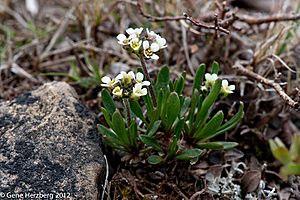Braya longii facts for kids
Quick facts for kids Braya longii |
|
|---|---|
 |
|
| Conservation status | |
| Scientific classification | |
| Genus: |
Braya
|
| Species: |
longii
|
Braya longii, also known as Long's Braya, is a tiny herbaceous flowering plant. It is a special kind of plant that grows only in cool, wet, and windy places. These places are along the coast of northern Newfoundland, Canada.
This plant is very rare. It is found in only a few small areas. All these spots are located on the northwest part of the Great Northern Peninsula.
Contents
What Does Long's Braya Look Like?
Long's Braya is a small perennial plant. This means it lives for many years. Its flower stalk grows right from the ground. It has thick, grey-green or bluish leaves at its base.
The plant stands up straight, usually only 1 to 10 centimeters tall. It loves soil rich in calcium. This means it needs to grow in limestone areas. It grows in limestone soil that has been moved around. This can happen naturally from frost or wind and water. Human activities like construction can also disturb the soil.
The plant has a deep taproot. This root helps it stay anchored and find water. In winter, the plant dies back to its base.
Flowers and Leaves
Long's Braya has white flowers with four petals. Each flower has four oval-shaped sepals. These sepals are green or slightly purple. The flowers grow in a cluster called a raceme.
Like other plants in the mustard family, each flower has four tall and two short stamens. The petals often have a bluish or reddish-purple tint. The leaves are long and narrow, like a spoon. They have pointed ends. Each leaf is about 1 to 4 centimeters long and 1 to 3 millimeters wide.
Why Is Long's Braya Endangered?
Long's Braya is a plant that needs our help. It was listed as an endangered species in Canada in 1997. It was also listed as endangered in Newfoundland and Labrador in 2002. This means it is at high risk of disappearing forever.
Main Threats to the Plant
The biggest danger to Long's Braya is losing its home. This happens when limestone is dug up for quarrying. It also happens when new roads are built. Community development also destroys its habitat.
Using Off-road vehicles can also harm the plant's habitat. Road and utility work can damage the areas where it grows. Climate change is another threat to this special plant.
Insects and diseases also threaten Long's Braya. A non-native insect called the diamondback moth eats the plant. There are also three tiny germs that can make the plant sick. Protecting its habitat is very important for its survival.


